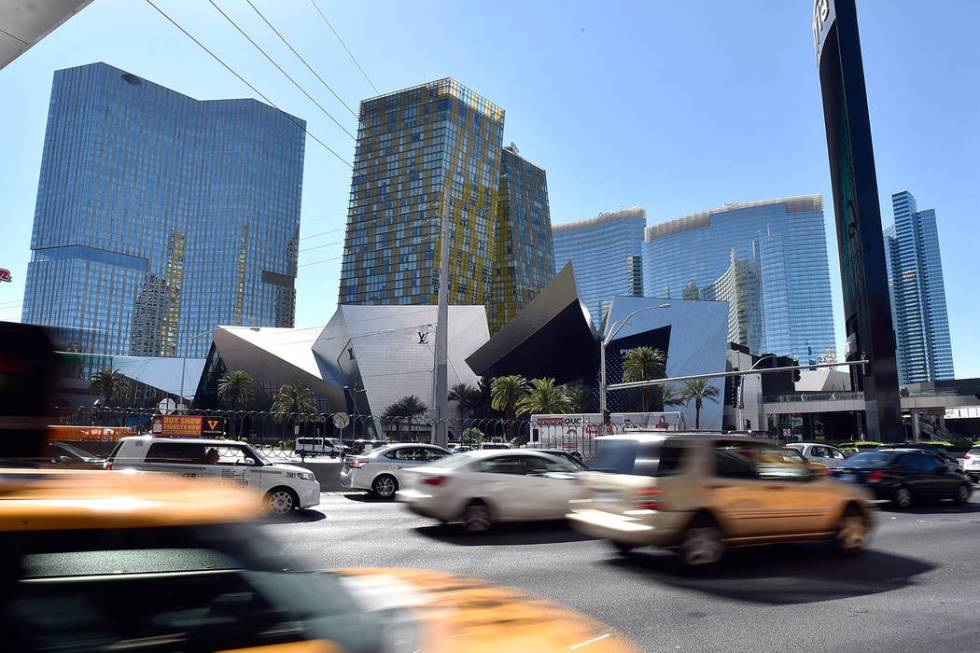Major street project on Las Vegas Strip begins in June

The Las Vegas Strip is set for a multiyear construction project that should be anything but entertaining for motorists.
The project, slated to reconstruct and repave a 5.7-mile portion of Las Vegas Boulevard from the 215 Beltway to Sahara Avenue, is scheduled to begin in June and be completed by July 2022, said Denis Cederburg, Clark County director of public works. The county and the Las Vegas Valley Water District will spearhead the project.
Aside from repaving Las Vegas Boulevard, the project also calls for water main replacements, adding an additional fourth lane where right of way allows, pedestrian enhancements, technology and infrastructure upgrades to the traffic system, adding LED lighting and enhancement to medians.
The water district will replace its entire water lot system along the stretch of Las Vegas Boulevard, including dual lines in some sections.
“Ultimately the intent to coordinate the Las Vegas Valley Water District replacement and our rehab is to reduce overall construction time frames and mitigate traffic congestion,” Cederburg said.
The three-year long project will be carried out in five phases, as the county aims to minimize traffic impacts in the area. Phase A — from Sahara to near Spring Mountain Road — is pegged to cost $33 million. Of that, $9.4 million will be derived from the water district for water line replacement work and $5 million from Resorts World for improvements adjacent to its property.
The total project cost has yet to be determined, Cederburg said.
Work will occur between 2 a.m. and 10 a.m. Monday through Thursday during the projects duration.
The county and various representatives of the resorts that line the Strip helped come up with the work timeline, according to Virginia Valentine, president of the Nevada Resort Association, who also sits on the Nevada Department of Transportation’s board of directors.
“Anytime there’s a project on Las Vegas Boulevard we’re very sensitive to how that’s going to impact what we’re doing,” Valentine said. “I think they’ve met with everyone up and down the corridor and I think they’ve tried to address their concerns about their construction projects, special events, their timeline and hours of construction.”
Those conversations with resort corridor stakeholders lead the county to decide to halt work for various large events including major conventions, National Finals Rodeo, the Las Vegas Rock N’ Roll Marathon and other major occurrences.
“We’ve coordinated with the major conventions to reduce the impact to conventioneers during those time frames,” Cederburg said.
Anywhere between 36,000 to 60,000 vehicles travel on the Strip daily, depending on the portion of the boulevard that’s being traveled at a given time, according to the county.
As each phase is carried out, lane reductions will vary. During working hours, lanes could be restricted to as few as one lane in each direction. During non-working hours, the county hopes to have at least two lanes in each direction open to travel.
“In most areas in the first phase we have three travel lanes in each direction, so that will reduce one travel lane for the duration of construction,” Cederburg said. “Other components south of Tropicana will have four lanes in each direction. So, the impact won’t be as great.”
The county also plans to have a large public outreach to keep employees of the various resort corridor businesses up to date on what work is taking place and when.
Part of the project includes making portion of the Strip from Sahara to the Welcome to Las Vegas sign a smart corridor, swapping existing light poles with smart poles that will serve as both small cell sites and lighting for the Strip.
Additionally, the county worked with resorts and utility entities to incorporate current and future infrastructure needs, Cederburg said.
“We’ve coordinated with Resorts World and Wynn West to provide widening in these areas,” he said.
In all, the resort association realizes the importance of the project and given the phased approach believes the county devised the best plan that could be developed given the magnitude of the project, Valentine said.
“This is an essential project, with critical infrastructure with the water line and the pavement is in pretty bad shape in a lot of locations,” she said. “Any time there’s construction there’s always disruption of traffic, but I think the long term benefits outweigh that. These projects are very much needed and we support the projects going forward.”
Contact Mick Akers at makers@reviewjournal.com or 702-387-2920. Follow @mickakers on Twitter.